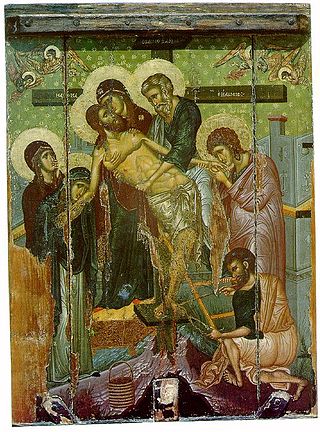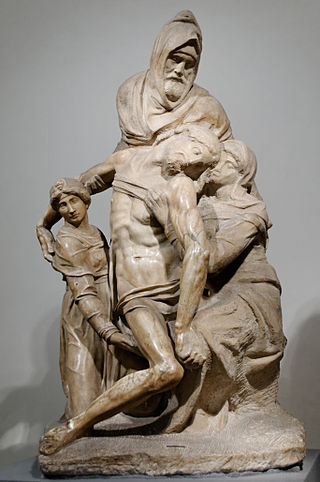
The Church of the Holy Sepulchre, also known as the Church of the Resurrection, is a church in the Christian Quarter of the Old City of Jerusalem. It is considered to be the holiest site for Christians in the world, as it has been the most important pilgrimage site for Christianity since the 4th century.

Joseph of Arimathea was, according to all four canonical gospels, the man who assumed responsibility for the burial of Jesus after his crucifixion. The historical location of Arimathea is uncertain, although it has been identified with several towns. A number of stories that developed during the Middle Ages connect him with Glastonbury, England, and also with the Holy Grail legend.

The Latin Patriarchate of Jerusalem is the Latin Catholic ecclesiastical patriarchate in Jerusalem, officially seated in the Church of the Holy Sepulchre. It was originally established in 1099, with the Kingdom of Jerusalem encompassing the territories in the Holy Land newly conquered by the First Crusade. From 1374 to 1847 it was a titular see, with the patriarchs of Jerusalem being based at the Basilica di San Lorenzo fuori le Mura in Rome. Pope Pius IX re-established a resident Latin patriarch in 1847.

The Pietà is a subject in Christian art depicting the Blessed Virgin Mary cradling the mortal body of Jesus Christ after his Descent from the Cross. It is most often found in sculpture. The Pietà is a specific form of the Lamentation of Christ in which Jesus is mourned by sole privilege of the Virgin Mary alone, whilst representing her "sixth sorrow" and sometimes accompanied by a specific Marian title.

The Anglican Province of Christ the King (APCK) is a Continuing Anglican church with traditional forms both of doctrine and liturgy. It is considered one of the more Anglo-Catholic jurisdictions among Continuing Anglican church bodies.

Nicodemus is a New Testament figure venerated as a saint in a number of Christian traditions. Depicted as a Pharisee and a member of the Sanhedrin who is drawn to hear Jesus' teachings, he is mentioned in three places in the Gospel of John:

Ramla or Ramle is a city in the Central District of Israel. Today, Ramle is one of Israel's mixed cities, with both a significant Jewish and Arab populations.

The Deposition is a marble sculpture by the Italian High Renaissance master Michelangelo. The sculpture, on which Michelangelo worked between 1547 and 1555, depicts four figures: the dead body of Jesus Christ, newly taken down from the Cross, Nicodemus, Mary Magdalene and the Virgin Mary. The sculpture is housed in the Museo dell'Opera del Duomo in Florence and is therefore also known as the Florentine Pietà.

The Catholic Church in Israel is part of the worldwide Catholic Church, in full communion with the Holy See in Rome. The Catholic Church in Israel is divided into three main jurisdictions: the Latin Patriarchate of Jerusalem, the Franciscan Custody of the Holy Land, and the Salesian Mission. Each of these jurisdictions has its own responsibilities and areas of operation.

In Eastern Orthodox Christian tradition the Myrrhbearers are the individuals mentioned in the New Testament who were directly involved in the burial or who discovered the empty tomb following the resurrection of Jesus. The term traditionally refers to the women who came with myrrh to the tomb of Christ early in the morning to find it empty. Also included are Joseph of Arimathea and Nicodemus, who took the body of Jesus down from the cross, annointed it with myrrh and aloes, wrapped it in clean linen, and placed it in a new tomb. In Western Christianity, the women at the tomb, the Three Marys or other variants are the terms normally used.

The burial of Jesus refers to the entombment of the body of Jesus after crucifixion, before the eve of the sabbath described in the New Testament. According to the canonical gospel narratives, he was placed in a tomb by a councillor of the Sanhedrin named Joseph of Arimathea; according to Acts 13:28–29, he was laid in a tomb by "the council as a whole". In art, it is often called the Entombment of Christ.

The Descent from the Cross is a panel painting by the Flemish artist Rogier van der Weyden created c. 1435, now in the Museo del Prado, Madrid. The crucified Christ is lowered from the cross, his lifeless body held by Joseph of Arimathea and Nicodemus.

The Catholic Church of Sts. Cyril & Methodius and St. Raphael in Manhattan, New York City has since 1974 been administered as the seat of a Croatian national parish. It offers services in Croatian as well as services in English.
Hapoel Ramla is an Israeli football club based in Ramla. They are currently in Liga Gimel Central division, and play home matches at the Ofer Park in Ramla.

The Shepherds' Field Chapel, or the Sanctuary of Gloria in excelsis Deo, is a Roman Catholic religious building in Beit Sahour, southeast of Bethlehem, in the West Bank, in Palestine. The chapel commemorates the annunciation of Jesus' birth to the shepherds, said to have taken place in Beit Sahour.

The Chapel of the Milk Grotto of Our Lady, also called Grotto of Our Lady or Milk Grotto, is a Catholic chapel in Bethlehem, in the West Bank of the State of Palestine, erected in 1872. Since Byzantine times, the place has been a center of Christian pilgrimage, maintained since its last erection together with its Marian shrine and monastery by the Custody of the Holy Land of the Order of the Friars Minor of the Catholic Church in Palestine. The Status Quo, a 250-year-old understanding between religious communities, applies to the site.

The Wedding Church at Cana or simply Wedding Church, also Franciscan Wedding Church, is a religious building of the Catholic Church located in the central part of the town of Kafr Kanna (Cana), in Lower Galilee, located in northern Israel. It is dedicated to the weddings of Christianity. Its name commemorates the event of the Wedding at Cana from the Gospel of John, thought by some Christians to have taken place on the site, during which Jesus performed his first miracle, by turning water into wine at the request or behest of Mother Mary.
Monastery of St. Nicodemus may refer to:



















